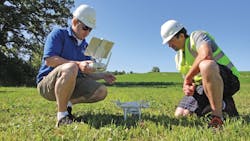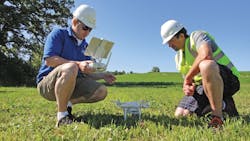The 333 is just a start
To society at large, “drone” is an ugly word.
A word that suggests incendiary deployments and targeted strikes. A word persistently ballooned by the global media. A word generally associated with conflict. But to many individuals and commercial enterprises alike, “drones,” or to name them correctly, unmanned aerial vehicles (UAVs) or unmanned aerial systems (UAS), mark a potentially progressive means of producing data on large-scale projects.
In order to operate UAVs, however, in any commercial capacity—including within road and bridge construction zones—a Section 333 Exemption must be achieved from the Federal Aviation Administration (FAA). This is not a reflection of bureaucracy, according to Peter Menet, owner and operator of Menet Aero, near Milwaukee but rather an extension of the FAA’s primary mandate.
“The FAA is primarily concerned with safety,” Menet told Roads & Bridges. “Of the aircraft, the airspace, the system and the operator.”
Write your own
When Peter Menet decided to apply his nearly 20 years of aviation experience as a Wisconsin National Guard pilot to the advancement of a business endeavor, commercial UAV/UAS operations weren’t even approved. “The Section 333 process was out, but no exemptions had been issued,” Menet said. “I wanted to use my aviation knowledge as a background to provide aerial data-collection services to companies that did not necessarily want to take full responsibility to operate UAVs on work sites.”
In 2012, Congress issued the FAA Modernization and Reform Act. Section 333 specifically authorizes the U.S. Transportation Secretary to determine if certain types of aircraft and certain activities can be operated safely within national airspace without the requirement of an airworthiness certificate. This section was intended to provide a means for commercial use of unmanned systems.
As systems became more automated, and pretty much anyone who could read directions could operate a UAV, piloting skills were consequently marred proportionate to the increase in ease of use. The 1982 Advisory Circular 91-57 law, which was meant to address modelers and model aircraft standards, was now being exploited by companies operating UAVs, on the logic that if they were not charging a client for the flying, UAV use was tantamount to flying a model airplane. Thus, in 2007 the FAA issued a policy letter closing this loophole by essentially taking the stance that UAV/UAS are aircrafts—and that all regulations that apply to manned aircraft also must then apply to unmanned UAV/UAS.
This presented its own particular problems.
“An aircraft must have a manual on board in the cockpit for the crew to access,” said Menet. “It must have seatbelts. You can see the problem right there. The reason the FAA had to take this stance is there were no proactive laws being drawn up to get ahead of this, but laws written reactively. They were faced with issues with no recourse. Court cases then allowed the FAA to completely enforce Title 14 CFR (the U.S. aeronautics code) on unmanned systems.”
Since the implication of manned aircraft standards on a quad-copter or 5-lb foam UAV were levelly ludicrous, the FAA instituted the Section 333 exemption process in order to address UAV use prior to getting down to the business of making a first set of rules.
So, how does it work?
“You write your own 333, is how it works,” Menet said. “I waited for the draft law to be issued, in order to first understand what the FAA was proposing. As an aviator, I don’t really operate with permission, but within guidelines. The Section 333 process is designed to give you specific authority to operate. So, you write to the FAA, submitting a document stating who you are, what your business is, what you’re going to be doing, how you’re going to be doing it and details about what type of aircraft you’ll be using. You provide manuals, explain how the system will react to a possible loss of linkage with the operator, what altitudes you’ll be operating at and what areas you’ll be operating in. And once you’ve done that—once you have basically been through all of Title 14 CFR, have identified every single section of the aeronautics code you feel should not apply to you and have stated exactly why it shouldn’t apply to you—then you have to explain how you’ll provide an equivalent level of safety.”
For example, having a manual on board the aircraft wouldn’t apply to a UAV operator because the UAV has no cockpit and no onboard area to store the manual. It adds too much weight and could not be accessed on the aircraft itself. An alternative safety measure would be to have the manual accessible by the operator at all times the UAV is being operated. Such levels of specificity, while they read like simple common sense, are crucial to the FAA’s defense of operability in domestic airspace. Moreover, exemption applications are a matter of public record—as are all communications between the applicant and the FAA. Though according to Menet, this doesn’t amount to much.
“During this entire process the only communication I got from the FAA was a receipt email. I don’t think they really expected to get all the 333s they did; it was meant to be a temporary process until the draft law was approved. But there’s hundreds.”
As of July 2015, 835 exemptions were granted.
Beyond the process
“You operate under what terms you put into your Section 333. They’re all granted on a case-by-case basis,” Menet said. “Of course, that’s just the starting point.”
If being granted a Section 333 Exemption is akin to getting your driver’s license, in the sense that it gives you permission to drive, then a certificate of waiver or authorization (COA) is the pink slip to your first car.
Peter Menet and an associate perform a pre-flight systems safety check before launching a small UAV.
A COA grants permission via local airspace authorities in the region in which a Section 333 exemptee will be operating. In theory, it is a simple means of tabulating and organizing UAV operations near major airports. Unfortunately, the FAA did not realize, or at least did not take into account, the myriad small rural airports and airstrips punctuating the country. For a UAV/UAS operator to have any reasonable expectation of chasing profitable work, he would need to, essentially, file COA after COA after COA; what’s more, he would need to take the COA process into account when chasing work in the first place. The process takes weeks, thus the operator would need to be practically prescient about where the next job was coming from. Consequently, the FAA created a “blanket COA,” which allows an applicant to follow specified rules without any further case-by-case COA. “For example, you must stay X number of miles away from an airport,” said Menet. “And if you do, you can operate near any area, provided you follow those rules. You don’t need a new COA for every new area you operate in.”
“It works great for rural areas,” Menet continued, “but I, for example, live in Milwaukee and about 60% of the greater Milwaukee area falls within the combined airspace of several airports. We’ve got Milwaukee International, Timmerman, Waukesha and Capital Drive. If you draw rings around what the blanket COA doesn’t cover, you’re not left with much air to operate. Unless you get additional COAs for those areas.”
There is a provision that would allow an operator to approach any given airport and basically “work it out” individually, but in practice, this is not as smooth or simple a process as it may sound. “The airport says this is the FAA’s deal,” Menet said. “But then the FAA says go talk to the airport, that’s what it says in your exemption. I spoke to someone from the FAA recently and was told they never expected anyone to go through that process for an international airport. Now I find myself again submitting a COA exemption to the FAA for these towered airports, which is a 60-day process.”
Couched within this protracted COA process is the undeclared, but crucial caveat of the respective airport’s’ independent requirements, divorced from those stipulated by the FAA.
“All of these types of COAs, like Section 333s, are issued on a case-by-case basis,” Menet said. “So just because my 333 said I don’t have to have a commercial pilot’s license, an airport could require that I do, which is another COA and a whole other set of criteria. So regardless of what your 333 says, the airspace owners can come up with their own requirements.”
To wit: the 333 is only the beginning.
“Just because you manage to get a 333, it doesn’t mean the flood gates are open,” Menet said. “It still requires a solid degree of aviation experience and expertise that a lot of companies can’t or won’t invest in. A lot of companies think, ‘Well, we’ve got someone out in the field, let’s give them a drone.’ The problem is that the airspace is so complex, and there is already a huge industry that uses the airspace and relies on it. Companies need someone with knowledge of these things. If you truly want to pursue UAS operations, then you have to get past the idea that you’re just a construction company, or just a geological surveying or civil engineering company, or a farming operation—you’ve got the have the aviation expertise to understand the full implications of what your doing. The paperwork is not enough; you’ve got to be able to fully backup what you claim you can do in that paperwork.”
The 4,500
Before final rules will be drafted and sent into the ratification process, the FAA held a public commentary period, by which questions and suggestions on the proposed rules would be considered. According to FAA spokesperson Les Dorr, some 4,500 comments were received before the commentary period closed in April of this year, each of which the FAA is statutorily required to address.
“We are now in the process of evaluating those comments,” Dorr told Roads & Bridges. “Some, which are unique, will be handled individually, while the remainder will be responded to categorically; for example, if we have X number of questions on safety or on privacy, we’ll respond to them under that umbrella. We expect to complete our portion of the final ruling by the end of this calendar year, and then the rule will undergo further executive review elsewhere in the government—through the U.S. DOT, for example, and other agencies—likely through late 2016, when we expect to be able to declare the rules final.”
According to a report issued by the Association for Unmanned Vehicle Systems International (AUVSI), FAA reauthorization must take place before the present authorization expires on Sept. 30, 2015. Which means what for the flood of commercial UAV/UAS exemptions, both those already granted and those as-yet unevaluated?
This is a rhetorical question, of course. Much like the uncertainty surrounding the ongoing long-term highway funding situation, no one has a satisfactory answer. What is certain is that UAV/UAS technology is not going away, but the FAA has declared itself open to enabling its potential and assuring its safe use. R&B

